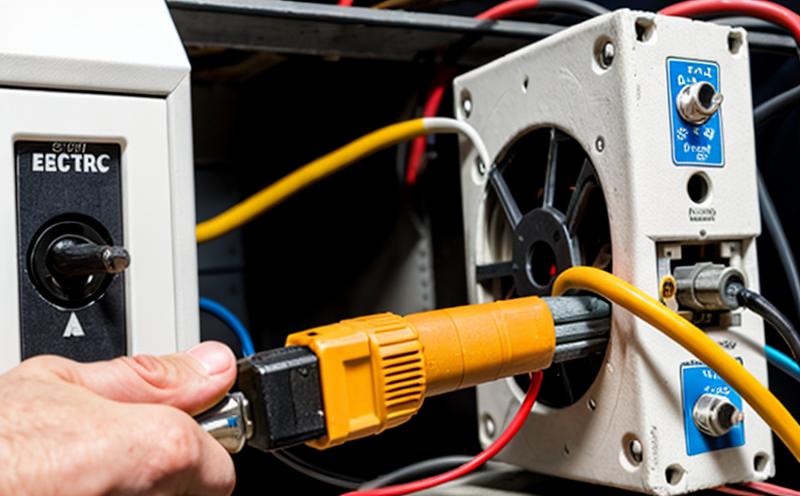EN 61000-3-2 Harmonic Current Emission Testing
The CENELEC standard EN 61000-3-2 specifies limits and methods of measurement to ensure that the electrical equipment used in buildings does not emit excessive harmonic currents into the building power supply system. This is crucial because harmonics can cause increased losses, overheating, and premature failures of electrical components.
The standard applies to AC voltage supplies up to 1000 V between each pole and neutral or earth (rms). The focus is on the frequency range of 5 kHz to 2 MHz. This includes both harmonic currents generated by equipment as well as inter-harmonic frequencies which are not addressed in other parts of EN 61000.
Compliance with this standard ensures that electrical devices operate within safe and efficient parameters, contributing to the overall reliability and longevity of infrastructure systems. Compliance officers must ensure their products meet these stringent requirements during the design and manufacturing phases.
The testing process involves connecting the device under test (DUT) to a power supply, ensuring that it operates at its nominal rated voltage and frequency. The emissions are then measured using an appropriate measurement system capable of capturing the harmonic content across the specified frequency range. The results should be compared against the limits defined in EN 61000-3-2.
Testing can reveal issues such as excessive current distortion, which could indicate poor design or manufacturing practices that need correction before market release. Quality managers and R&D engineers play crucial roles in ensuring these tests are conducted rigorously to maintain product quality and safety standards.
The testing procedure is essential for compliance with regulatory requirements and ensures that the equipment does not interfere with other devices sharing the same power supply. This is particularly important in industrial settings where multiple pieces of machinery may be connected to a single power source, increasing the risk of interference from non-compliant equipment.
Compliance with this standard can also enhance customer satisfaction by ensuring reliability and performance consistency across different installations. It promotes trust between manufacturers and end-users who rely on these devices for critical operations.
To summarize, EN 61000-3-2 is a vital part of the regulatory framework that ensures electrical equipment operates safely within power supply systems. By adhering to this standard during development stages, manufacturers can avoid costly recalls post-launch and ensure long-term satisfaction among customers.
Industry Applications
| Industry Sector | Benefit of Compliance |
|---|---|
| Data Centers | Avoids interference with sensitive IT equipment |
| Telecommunications | Ensures stable power supply for communication devices |
| Manufacturing Plants | Precise control over production processes |
| Commercial Buildings | Reduces energy consumption and operational costs |
| Residential Complexes | Improves comfort and reliability of appliances and electronics |
| Measurement Point | Description |
|---|---|
| Supply Voltage | The voltage at the point of common coupling (PCC) to which the DUT is connected. |
| Demand Current | The current drawn by the DUT from the supply, measured at the PCC. |
| Harmonic Currents | The harmonic components of demand current, measured using a spectrum analyzer or similar instrumentation. |
Quality and Reliability Assurance
Compliance with EN 61000-3-2 is essential for maintaining high-quality standards in the design, manufacturing, and operation of electrical equipment. This standard ensures that all devices emit harmonics within specified limits, thereby preventing interference between different pieces of equipment on a common power supply.
The testing process involves several key steps aimed at achieving reliable performance under various operating conditions. These include:
- Initial setup: Ensuring the DUT is correctly connected to the power supply and operates at nominal voltage and frequency.
- Data collection: Using specialized equipment to capture harmonic emissions across the specified frequency range.
- Analysis: Comparing measured values against the limits set out in EN 61000-3-2.
- Correction if necessary: Adjustments made based on analysis results to bring any non-compliant devices into compliance.
Achieving consistent quality through this process not only meets regulatory requirements but also enhances customer confidence and satisfaction. It is particularly important for industries where precision and reliability are paramount, such as data centers or telecommunications networks.
Regular testing ensures that any potential issues are identified early in the production cycle rather than after product release, saving significant costs associated with recall campaigns or warranty claims. This proactive approach helps maintain brand reputation and fosters trust among stakeholders.
International Acceptance and Recognition
EN 61000-3-2 has gained widespread recognition across various countries due to its comprehensive approach towards managing harmonic emissions in electrical equipment. The standard is widely adopted by manufacturers worldwide as it provides a consistent framework for ensuring compliance.
Many jurisdictions have incorporated EN 61000-3-2 into their local regulations, making adherence mandatory for certain types of products. For example:
- In Europe, the regulation covers all non-linear loads connected to public electricity networks.
- In North America, specific states like California require compliance with this standard for new installations and renovations involving equipment likely to cause harmonic distortion.
The acceptance of EN 61000-3-2 extends beyond geographical boundaries; it is recognized globally by international bodies such as the IEC and ISO. This recognition ensures that products meeting this standard are accepted in multiple markets without additional certification requirements.
In summary, compliance with EN 61000-3-2 is not just a local requirement but an international best practice recognized across numerous countries and regions. Adhering to these standards helps manufacturers expand their market reach while ensuring product quality and reliability.





